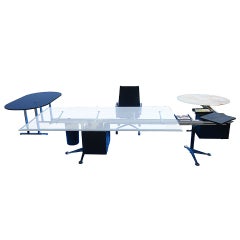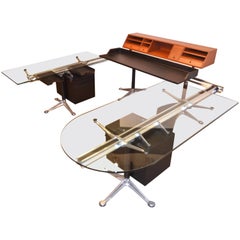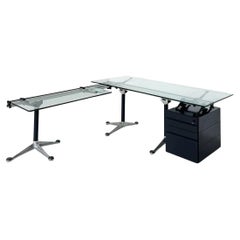Herman Miller Glass Desk Table By Bruce Burdick
Late 20th Century American Mid-Century Modern Desks and Writing Tables
Onyx, Granite, Aluminum
Recent Sales
Vintage 1980s American Mid-Century Modern Desks and Writing Tables
Aluminum
Vintage 1980s American Desks and Writing Tables
Crystal, Aluminum
Vintage 1970s American Mid-Century Modern Desks
Marble, Metal
Late 20th Century American Desks and Writing Tables
Aluminum
Late 20th Century American Desks and Writing Tables
Aluminum
Late 20th Century American Desks and Writing Tables
Marble, Aluminum
Vintage 1980s American Post-Modern Desks and Writing Tables
Aluminum
Vintage 1980s American Post-Modern Desks and Writing Tables
Aluminum
Vintage 1980s American Post-Modern Desks and Writing Tables
Aluminum
Late 20th Century American Modern Dining Room Tables
Aluminum, Metal
Vintage 1980s American Post-Modern Desks
Carrara Marble, Steel
Late 20th Century American Desks
Aluminum, Steel
20th Century Unknown Mid-Century Modern Desks and Writing Tables
Aluminum
Vintage 1980s American Modern Desks and Writing Tables
Aluminum
People Also Browsed
20th Century English Art Deco Commodes and Chests of Drawers
Chrome
2010s American Mid-Century Modern Decorative Art
Ceramic
Vintage 1960s Danish Mid-Century Modern Dining Room Tables
Teak, Wenge
Vintage 1960s German Mid-Century Modern Musical Instruments
Aluminum
Vintage 1930s Art Deco Table Lamps
Metal
Vintage 1940s American Mid-Century Modern Cabinets
Walnut
1970s Pop Art Prints and Multiples
Lithograph
Vintage 1960s French Mid-Century Modern Chairs
Metal, Chrome
Antique 19th Century English Dining Room Tables
Mahogany
Vintage 1960s American Modern Dressers
Marble, Aluminum, Steel
Vintage 1950s Central American Mid-Century Modern Books
Paper
Vintage 1970s American Mid-Century Modern Desks
Stainless Steel
Vintage 1970s Italian Mid-Century Modern Credenzas
Stone
Vintage 1960s American Hollywood Regency Side Tables
Brass
Vintage 1960s French Hollywood Regency Architectural Elements
Brass, Chrome
Vintage 1930s Swedish Art Deco Porcelain
Porcelain
Finding the Right Desks-writing-tables for You
Choosing the perfect writing desk or writing table is a profoundly personal journey, one that people have been embarking upon for centuries.
Queen Atossa of Persia, from her writing table circa 500 B.C., is said to have been the originator of the art of handwritten letters. Hers was reportedly the first in a long and colorful history of penned correspondence that grew in popularity alongside literacy. The demand for suitable writing desks, which would serve the composer of the letters as well as ensure the comfort of the recipient naturally followed, and the design of these necessary furnishings has evolved throughout history.
Once people began to seek freedom from the outwardly ornate styles of the walnut and rosewood writing desks and drafting tables introduced in the name of Queen Victoria and King Louis XV, radical shifts occurred, such as those that materialized during the Art Nouveau period, when designers longed to produce furniture inspired by the natural world’s beauty. A prime example is the work of the famous late-19th-century Spanish architect Antoni Gaudí — his rolltop desk featured deep side drawers and was adorned with carved motifs that paid tribute to nature. Gaudí regularly combined structural precision with decorative elements, creating beautiful pieces of furniture in wood and metal.
Soon afterward, preferences for sleek, geometric, stylized forms in furniture that saw an emphasis on natural wood grains and traditional craftsmanship took hold. Today, Art Deco desks are still favored by designers who seek to infuse interiors with an air of luxury. One of the most prominent figures of the Art Deco movement was French decorator and furniture designer Émile-Jacques Ruhlmann. With his use of neoclassical motifs as well as expensive and exotic materials such as imported dark woods and inlays of precious metals for his writing desks, Ruhlmann came to symbolize good taste and modernity.
The rise in appreciation for Scandinavian modernism continues to influence the design of contemporary writing desks. It employs the “no fuss” or “less is more” approach to creating a tasteful, sophisticated space. Sweden’s master cabinetmaker Bruno Mathsson created gallery-worthy designs that are as functional as they are beautiful. Finnish architect Alvar Aalto never viewed himself as an artist, but, like Mathsson, his furniture designs reflected a fondness for organic materials and a humanistic approach. Danish designers such as Hans Wegner introduced elegant shapes and lines to mid-century desks and writing tables, often working in oak and solid teak.
From vintage desks to contemporary styles, 1stDibs offers a broad spectrum of choices for conducting all personal and business writing and reading activities.


